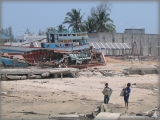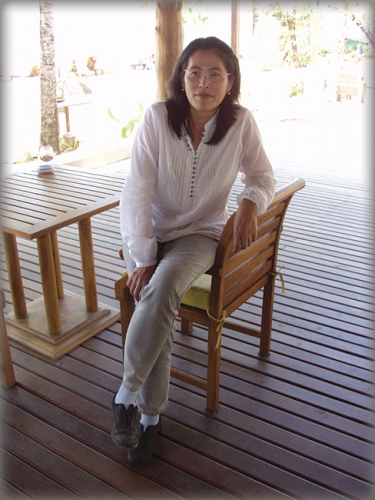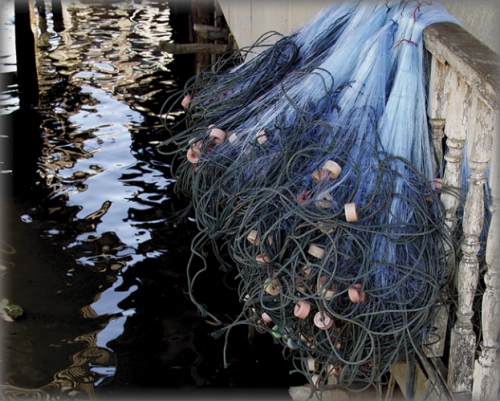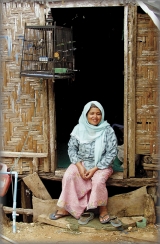On December 26, 2004, Chuleeporn Sermsirimanont was away from her office at the Khao Lak Paradise Resort, where she is the owner and manager. But her husband was on duty there, in a building perched high on a wooded bluff above a postcard-pretty scene: aqua sea, white sand, and the lush, emerald green of the hotel grounds.
Suddenly, the sea disappeared, leaving a gray, eerie wasteland of sand. And then, just as suddenly, the sea came raging back. A huge mound of water raced inland, snapping the palm trees, tossing the buildings apart in the surge. Chuleeporn’s husband watched as the body of one of their guests bobbed toward him through wreckage and trees.
On this stretch of beach in Thailand’s Phang-nga province, the tsunami killed three thousand people. “We lost four guests and six staff members,” Chuleeporn says. “Seventy percent of the hotel was destroyed.”
Asked if she and her family have recovered from their losses, Chuleeporn smiles politely, as though the question has an answer too personal to share. “We have rebuilt,” she says. “We are ready for guests.”
The casualties were more numerous a short drive down the beach, where a twelve-meter wall of water hit the beachfront buildings and ripped Kiat Sriprasom’s upscale hotel, the Seaview Resort and Spa, right off its footings, leaving only piles of rubble and twisted rebar. Kiat lost a hundred guests and twenty-four staff members. Some of the staff were longtime employees who had followed Kiat to Khao Lak from his previous job in Phuket.
“Losing those people was terrible,” Kiat says. “The day after the tsunami, there was nothing but ruin. There was no power. Bodies were still in the wreckage. It was like the Stone Age.”
Throughout coastal Thailand, reminders persist. In Khao Lak, a one-hundred-foot police patrol boat, stranded two-thirds of a mile inland by the tsunami, rests off-kilter in a field. Piers are still in ruins, the fishing boats broken and sunk. Repairs to water-supply pipes are lagging, and shortages still plague the area during peak demand.
But it’s not the Stone Age now. In most locations, the power is back on, roads are open again, and cell phones are jingling. Crews are rebuilding the hotels, higher and stronger. And slowly, the tourists return. But demand for hotel rooms remains much lower than before the tsunami, and Kiat is worried. By February of this year, his hotel was 70 percent rebuilt and open for business. But many hotel workers died in the tsunami, so Kiat has trouble finding qualified staff. And his rooms don’t command the premium prices they once did. Before the tsunami, Kiat charged 4,500 baht (about $139 U.S. dollars) per night for one of his luxury hotel rooms. This February, during the height of the tourist season in southern Thailand, he could only charge 2,500 to 3,000 baht (about $77 to $92 U.S. dollars). In January, his occupancy rate was only 60 percent. Before the tsunami, it was typically 90 to 95 percent, he says.
The problem is a matter of simple supply and demand, Kiat says. While tourists from Scandinavia and Europe have found their way back to Khao Lak, visitors from Asia and elsewhere have been slow to return. Kiat offers one explanation: “They are afraid of ghosts,” he says. “Thousands of ghosts.”
The “second tsunami”
If you ask Kiat what to do about the ghosts, he will say, “Care for the living.”
Easier said than done. After the tsunami, relief organizations, missionaries, reporters, and well-intended volunteers flooded southern Thailand, often using up precious resources and getting in the way.
“We called it ‘the second tsunami,’” says Jack Kasarda, a professor of business and director of UNC’s Kenan Institute of Private Enterprise. “Everyone from around the world was coming to help. It was a mess. We decided to focus on recovery, rather than relief.”
Kasarda, an expert in international business and air transport, is a member of the board of trustees of Kenan Institute (K.I.) Asia, a not-for-profit organization based in Bangkok with close ties to UNC-Chapel Hill. For years, Kasarda has steered UNC students and faculty toward service and study in Asia. Kasarda can be a tad evangelical about Thailand and the advantages of working there. Thailand, he says, is beautiful and its culture is splendid; it has been among the fastest-growing economies in the world; Americans are welcome; and Bangkok is only a brief plane ride from the political and economic power centers of Asia. And for anyone interested in international business, Asia is where the action is these days.
Kasarda’s affection for Thailand pushed him into overdrive after the tsunami. He and K.I. Asia leaders met with Thai government officials and business leaders to build support for the program they had in mind—one that would help put people back to work.
The effort required funding, and Kasarda found it. With Erskine Bowles, president of the UNC system, Kasarda landed $200,000 from the Bush-Clinton tsunami-relief fund. The Kenan Charitable Trust committed another $1 million, 25 percent of which funds UNC students and faculty members working in the tsunami-recovery effort; the rest goes to K.I. Asia for an array of new projects.
One example of such projects is an effort to help rebuild the fishing industry. The tsunami killed fishermen and destroyed boats, nets, fish traps, docks, and cold-storage facilities. K.I. Asia has helped local authorities acquire land to build a new pier for small-boat fishermen in the community of Tab La Mu Port, and several Kenan-Flagler Business School students worked to launch the project. Construction began this summer.
The ripple of money
Along the southern coast, much of K.I. Asia’s recovery effort has focused on rebuilding the tourist industry in a way that attracts bigger spenders. “Upper-end tourism is the way the money is really going to pour in here,” Kasarda says. “And that starts with the hotels and ripples through the economy creating jobs.”
In the past, much of the tourism in places such as Khao Lak consisted of day trips that generated little revenue. Khao Lak, Kasarda says, has the potential to attract the kind of tourists who seek pristine beaches and picture-perfect scenery. But for high-end tourists, the entire experience has to be first-rate, from the natural beauty of the environment to the service in the restaurant and the furnishings in the hotel room. Creating that experience takes real expertise and close cooperation among the local businesses and governments—ingredients sorely lacking in the aftermath of a disaster.
In coastal areas of Thailand, much of K.I. Asia’s effort has been directed toward providing those missing ingredients. K.I. Asia staff arranged training for hotel operators, front-office workers, and food-and-beverage managers. UNC students arrived to help develop new business strategies (see “Back in Business”). The team also helped organize the Phang-nga Tourist Association, of which Kiat Sriprasom is vice president. The association has fifty-four members and promotes practices that help businesses attract and please guests who have money to spend.
Richard Bernhard, associate executive director of K.I. Asia, says that one of the advantages of working in Khao Lak is that most of the hotel owners are locals, so profits are likely to remain in Thailand and benefit the Thai people.
“The goal is to make Khao Lak an international destination for sustainable tourism,” Bernhard says. UNC students from programs in business or information and library science are helping local businesses craft new marketing campaigns.
“The whole tourism trade here was based on word of mouth,” Bernhard says. “The students will help produce the kind of web sites and brochures that can appeal to travelers all over the world.”
Beyond the posh resort
But not everyone in Thailand can run a resort or make a living from the tourist trade, and K.I. Asia invests many of its resources in projects designed to foster local ownership of business. Paul Wedel, executive director of K.I. Asia, says that in Southeast Asia, outside investors often build fancy hotels or other developments that drive up land and food prices, damage the environment, and offer only low-paid jobs to local workers.
“In the early 1990s, Thailand’s growth was rapid and not sustainable over the long term,” Wedel says. “Ever since then, social and environmental goals have been part of our mission.”
Sustainable development is a notion that has survived for decades despite the lack of a clear definition, but the general idea is that development must be economically, socially, and environmentally sound in order to sustain a community or society for many generations. A weak economy tends to impoverish people and degrade the environment, just as the absence of social justice or environmental quality can undermine the economy. K.I. Asia seeks a balance among the three dimensions of sustainability, Wedel says.
“For example, when we provide management consultation to a company, the goal is to benefit society and the environment at the same time we’re strengthening the business,” he says.
Many of K.I. Asia’s projects have involved organizing and training entrepreneurs, especially women (see “Small Loans, Big Results,”). In the first fifteen months following the tsunami, K.I. Asia’s programs involved fifteen hundred people.
But Wedel quickly points out that this number is modest, given the need. The tsunami ripped out much of the social fabric of coastal Thailand along with its towns and businesses. Shortages of Thai workers and demand for new construction increased the number of low-paid workers from Burma and elsewhere. Agriculture also took a hit, and chicken farms and rubber plantations attracted foreign workers, compounding Thailand’s public-health problems.
Malevolent microbes
The influx of foreign laborers and their families has spread malaria into some border areas of Thailand, especially in the rubber plantations, where mosquitoes thrive. Malaria threatens not only public health but the Thai economy, because the disease affects the very workers Thailand needs to rebuild its infrastructure and resume its economic momentum, and because the tourist trade will suffer if malaria reaches the southern islands and beaches.
While malaria can be treated, there are two distinct types in Thailand, and drug-resistant strains have begun to appear elsewhere in Southeast Asia. Successful treatment requires an accurate diagnosis—a difficult and expensive step in rural areas. Jim Hopkins, manager of K.I. Asia’s Borderless Action Against Microbes project, says that widespread screening for malaria in rural areas has been impractical because reliable tests have required a microscope and skilled technicians.
“We know that early detection and containment in villages stops the transmission cycle,” Hopkins says. “But the weakest link in the chain is diagnosis.”
With funding from the U.S. Agency for International Development (USAID), K.I. Asia has supported work by Thai researchers to develop a field test for malaria. The test, which involves a small strip that changes colors when malaria is present in a drop of blood, has shown promise in the first round of field trials. Unlike commercial test strips tried previously, the new version appears to be relatively stable in the heat and humidity of Thailand. If the next round of field trials confirms the early results, the test kits could help Thai public-health workers bring the disease under control.
But as serious as malaria can be, its threat pales by comparison to that posed by another disease that remains in the shadows, biding its time: avian flu. Almost everywhere in rural Thailand, people and birds share living space. Birdcages hang in the food stalls of public markets. Chickens wander in and out of houses and open-air kitchens. Children feed the family’s fowl and handle them daily. If the disease does make its dreaded leap from birds to people, the first outbreak could very well happen here.
With support from USAID and UNICEF, Hopkins is leading a K.I. Asia effort to lower the odds that avian flu will make that leap. In addition to working with agencies and communities on emergency preparedness, his project has developed educational posters, teachers’ guides, and computer programs to educate school children about the risks of avian flu. The materials, which use cartoons and illustrations to help children learn better hygiene and safety skills, are used in 40,000 Thai schools and have also been adapted for Burmese refugees, 150,000 of whom are living in camps in rural Thailand.
A place for UNC
Given the public-health challenges in Southeast Asia, UNC can and should expand its work there, says Peggy Bentley, associate dean for global health in the School of Public Health. In February, Bentley traveled to Thailand and investigated public-health problems wrought by the tsunami.
“Part of what happens when you have a tsunami or any natural disaster like that is a contaminated environment,” Bentley says. “The water and soil become contaminated with fecal material, and that contamination drives the spread of infectious disease.”
Bentley is working with K.I. Asia and Tom Outlaw, a student in the Kenan-Flagler business school, to develop business models for producing and distributing inexpensive devices for filtering water. The filters, developed by Mark Sobsey and his doctoral student in environmental sciences and engineering, Joe Brown, greatly reduced the spread of diarrheal diseases when the devices were tested in Cambodia. (See Endeavors, Fall 2006, “Water, Water Everywhere.”)
Carolina has also collaborated withThailand’s Population and Community Development Association, which recently won the 2007 Gates Award for Global Health. As a senior studying environmental health science, Andrew Shapiro worked with the association in the Krabi community to create a biodiesel reactor for converting vegetable oils into fuel. (See Endeavors, Fall 2006, “Biofuel for Thailand.”)
For Jack Kasarda, it’s good news any time UNC students or faculty members venture into Asia. But he’s pushing for more. Back in 1990, when he became director of the Kenan Institute of Private Enterprise, it was already clear to him that the twenty-first century would be “the Asian Century,” he says, a time when rise of industrial might in China, India, and Southeast Asia would shift the economic center of the globe from the West to the East. And if you want to understand this new landscape, Kasarda argues, Thailand is a good place to begin.
“Carolina has a future in Asia,” Kasarda says. “Whatever you’re interested in—business, scientific research, social science, public health, environment, history, culture—you can work there and be part of something truly exciting. Tsunami recovery is one good example. We’ve seen that our students can work with an organization like K.I. Asia and make a real difference in the way a country rebuilds.”
Neil Caudle was the editor of Endeavors for fifteen years.
The malaria diagnostic test, supported by K.I. Asia with funding from USAID, is developed by Ponwit Bualombai of the Bureau of Vector Borne Diseases in the Department of Disease Control and by Panadda Thepaksorn of the Biotechnology Center in the Department of Medical Science, both within Thailand’s Ministry of Public Health. Nakorn Amornwatpong is K.I. Asia’s manager for the recovery program in Phang-nga. An agreement between UNC’s School of Public Health and Mahidol University’s School of Public Health has enabled numerous exchanges for faculty and students. Jack Kasarda is also Kenan Distinguished Professor of Entrepreneurship at UNC. Tony Waldrop, UNC’s vice chancellor for research and economic development, is also a member of the K.I. Asia board of trustees. For more information on K.I. Asia, visit www.kiasia.org.









